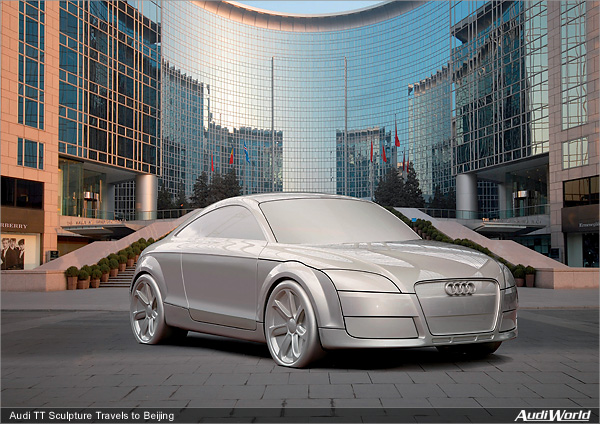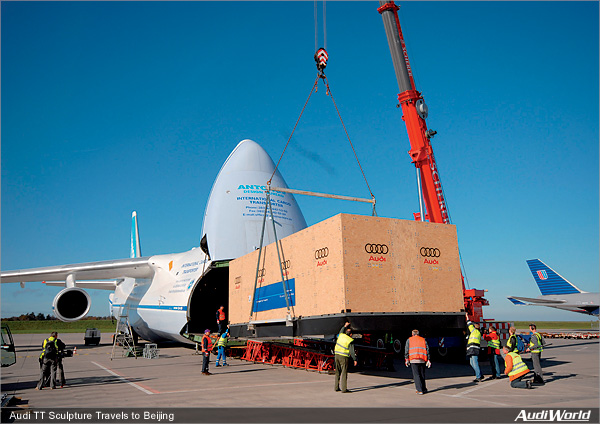A Symbol of Dynamism: Audi TT Sculpture Travels to Beijing

Beijing. The unique sculpture made its debut at the Brandenburg Gate in Berlin and its next port of call is an equally spectacular setting: on 18 November Prof. Dr. Martin Winterkorn, Chairman of the Board of Management of AUDI AG, will unveil this outsize version of the current Audi TT on Changan Avenue, the Chinese capital’s great east-west artery. During the “Auto China 2006” motor show (19 to 27 November) the sculpture will underline the Audi brand’s presence on this ever-dynamic car market. Audi is enjoying great success in China: between January and October 2006 a total of 66,634 cars sporting the four-ring badge were sold here, some 60 % up on last year. A place on Beijing’s main thoroughfare However, the sculpture stands for more than the Audi brand’s dynamic performance on the Chinese market it also represents the future of Audi design. After all, the model, which stands 10.20 metres long, 4.50 metres wide and 3.25 metres high, bears the unmistakable features of the Audi TT a TT in XXL format or, to be exact, 2.5 times the size of the original car. Its shoulder line is a whole two metres high, so pressing your nose up to the window is no mean feat, even for the tallest among us. In a city of 15 million people, Changan Avenue, the Avenue of Eternal Peace, is the busy main thoroughfare leading to Tiananmen Square, the Square of Heavenly Peace with the Great Hall of the People and the Forbidden City of imperial times. The avenue will be home to the largest Audi of all time for around four weeks, where it will stand in front of the Oriental Plaza, a magnificent new commercial complex in the heart of the city. This houses the Audi Forum Beijing, a showcase for the brand in China with space to exhibit vehicles and hold events. A top snapshot in Berlin The public had their first glimpse of the sculpture on 6 April in Berlin: Prof. Dr. Martin Winterkorn and Germany’s Vice Chancellor Franz Müntefering unveiled “The Automobile” just in front of the Brandenburg Gate as a contribution from AUDI AG to the initiative “Germany Land of Ideas” promoting German industry during the Football World Cup. For weeks the sculpture stood as a symbol of the automobile one of the greatest inventions to come out of Germany and one of the country’s most important industries. In front of the Brandburg Gate and in its later location at the foot of the Victory Column, the sculpture became one of the capital’s most photographed features. Following its brief tour of Berlin, the sculpture took up temporary residence at Munich Airport between Terminals 1 and 2, before continuing on its voyage to the Far East. Whereas an “ordinary” abnormal load movement with police escort was sufficient for the journeys to Berlin and Munich, for the flight to Beijing an aircraft with dimensions to match those of the sculpture had to be chartered.
Giant aircraft to fly the largest Audi The Antonov An-124 is one of the largest cargo aeroplanes in the world and within its 37-metre-long cargo hold (its external length is 70 metres) it can carry payloads of up to 120 tonnes. Some 20 of these aircraft are in service in the freight business worldwide for Ukrainian and Russian cargo carriers and they are unbeatable for urgent abnormal airfreight of all kinds. In the case of the XXL TT the critical issue was not weight, as the sculpture is made of a modern foam plastic called Neopor and, together with its steel frame, actually weighs “only” around ten tonnes. Fuselage cross-section is what counted: the sculpture in its wooden box only just fitted through the 6.40-metre-wide and 4.40-metre-high cargo hatch under the Antonov’s nose, which hinges upwards for loading. The packing and transport was professionally organised and carried out by DHL Global Forwarding. Accompanying the sculpture in the Antonov were the exhibits from AUDI AG for the “Auto China 2006”, which were all painstakingly secured in cargo containers. The products must, after all, reach the motor show without a scratch on them. One of the containers housed the new Audi R8 sports car, making its Asian debut in Beijing. A few original-size examples of the Audi TT were also on board, since the new sports coupé is due to be launched on the Chinese market before the end of the year. Audi very successful in China So far, 2006 has been an extremely successful year for Audi in China: between January and October the company sold 66,634 cars there, already more than in the whole of 2005. The main success stories have been the Audi A6 L, exclusively built for China with an extended wheelbase, and the Audi A4. Both are produced in Changchun in northern China. In the locally manufactured premium segment Audi has a market share of over 50 percent. Nevertheless, the imported Audi models are also very popular. The top model Audi A8 L, for instance, has enjoyed a 55 % increase in sales compared to last year. Alongside it, the Audi Q7 has already had a very successful Chinese launch.
|

